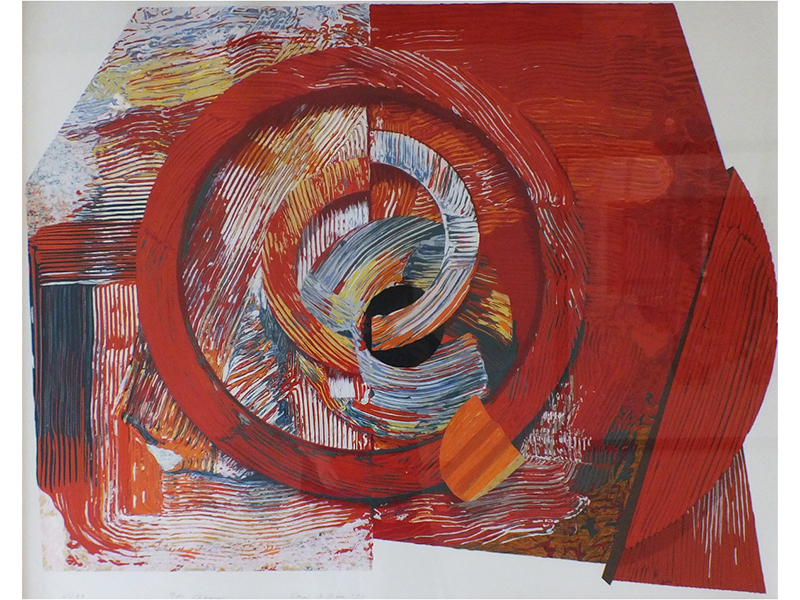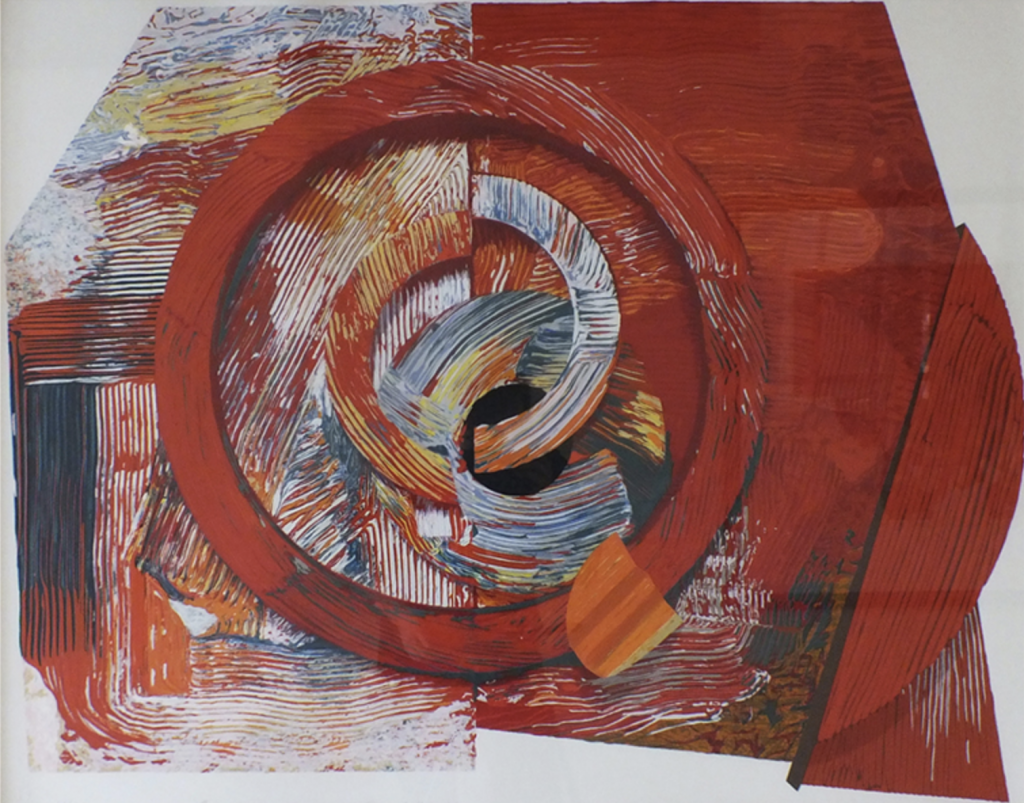- 1 Drexel Drive, New Orleans, Louisiana
Our Collection
For Xavier
Sam Gilliam


Sam Gilliam, b. 1933, American, For Xavier, Linocut/color screen-print on paper, Signed in pencil, 61/99 in series, 32” h x 40 ¼” w
1990
This vibrant work by Sam Gilliam exemplifies the exuberance and unconventionality of this famed artist. Simply titled For Xavier, this piece is part of a series created to benefit the students of Xavier University of Louisiana. Gilliam is known for his experiments with color, and has been internationally recognized as the foremost contemporary African American Color Field painter for over three decades. In this work, Gilliam employs a method he discovered in the 1970s, involving cutting heavily painted pieces of canvas and paper into geometric shapes and rearranging them into new compositions. Gilliam had spent the first part of his career exploring the limits of color application on unstretched canvases, creating painting that were three-dimensional, mobile and fluid. With this new assemblage style, he evokes the African-American tradition of crazy quilts in both method and form. Printed by Stovall Printmaking Workshop in Washington, D.C., this print explodes from the paper in a harmonious dance of color.
“Abstract art is political because it messes with you, it challenges you to understand something different. [Abstract art] is philosophically the holistic experience of the artist revealing his presence in the world.
It’s fun to fail. You learn something: how not to fail!”
-Sam Gilliam

About the Artist
Sam Gilliam was born the seventh of eight children in Tupelo, Mississippi in 1933. He was interested in art even as a young child, and recalled being inspired by watching a painter in his community by the name of Cassius Marcellus Clay, Sr. paint murals. He was painting seriously by elementary school and received special encouragement by his fifth grade teacher. By this time, his family had moved to Louisville, Kentucky, and in 1951, Gilliam, graduated from Central High School in Louisville. In 1955, he graduated with a bachelor of arts degree in fine arts from the University of Louisville, where he had his first solo exhibition. He also enrolled there as a graduate student, but his education was put on hold as he served in the United States Army from 1956 to 1958. He returned to the University of Louisville following his discharge, and completed his master of arts degree in fine arts in 1961.
Upon graduation, Gilliam taught art in the Louisville public schools. In 1962 he married journalist Dorothy Butler, who was the first Black female journalist at The Washington Post. The couple moved to Washington, D.C., in part because of the work being done by the Washington Color School. In his first years showing his work, he made friends with painter Tom Downing, who attended Gilliam’s first show, which he deemed “pretty bad”, with the exception of a watercolor.
Gilliam’s career has also been marked by his role as a teacher and as a public artist. Beginning as a teacher in Louisville public schools, Gilliam went on to teach in the Washington public schools for nearly a decade, and then at the Maryland Institute, College of Art and the University of Maryland, and for several years at Carnegie Mellon University in Pittsburgh. One of the few successful, self-supporting African American artists who views the teaching of art as a mission, Gilliam conducts workshops, lectures and participates in panels all over the world.
An outstanding creator of public art, Gilliam frequently works on a monumental scale and has received numerous major public commissions around the country. Some of his most notable works are grace metro stations and airports such as the Jamaica Center Train Station in New York, and the Seattle- Tacoma International Airport, which features 2004’s Yellow Fog mosaic column.
In recognition of his role as an artistic revolutionary, Gilliam has received eight honorary doctorates, including an Honorary Doctorate of Humane Letters from his alma mater, in 1980. In 1972, he became the first African-American artist to represent the United States at the Venice Biennale, and was invited back in 2017. He has also been awarded two National Endowment for the Arts awards, fellowships from the Washington Gallery of Modern Art and the Guggenheim Foundation. In 2006, the University of Louisville also named him Alumnus of the Year.
Today, Gilliam’s work is in ever-increasing demand. He currently has a long-term installation on view at Dia:Beacon, Beacon, New York, which opened in 2019. In addition to a traveling retrospective organized by the Corcoran Gallery of Art, Washington, D.C. in 2005, Gilliam has been the subject of solo exhibitions at Kunstmuseum Basel, Switzerland (2018); Phillips Collection, Washington, D.C. (2011); J.B. Speed Memorial Museum, Louisville, Kentucky (1996); Whitney Museum of American Art, Philip Morris Branch, New York (1993); The Studio Museum in Harlem, New York (1982); and the Museum of Modern Art, New York (1971), among many other institutions. His work is included in over fifty public collections, including those of the Musée d’Art Moderne de la Ville de Paris; Tate Modern, London; the Museum of Modern Art, New York; the Metropolitan Museum of Art, New York; the Louisiana Museum of Modern Art in Denmark; and the Art Institute of Chicago. In 2022, Sam Gilliam will be the subject of a major retrospective exhibition at the Hirshhorn Museum, Washington, D.C.

Context
Gilliam had a number of influences, from Giotto and Tintoretto to comic books, Paul Klee and the German Expressionists. During this time, Abstract Expressionism of the New York School was the predominant movement in the art world, thanks to wildly charismatic artists such as Jackson Pollock. In response to this dominant aesthetic, which emphasized gesture, Gilliam and artists like Morris Louis, Kenneth Noland, and Alma Thomas began to explore color for its own sake. Known as the Washington Color School, this group put color and pigment at the center of their work, favoring techniques such as wet fabric staining and pouring paint on the canvas, a technique known as hard edge painting. They explored the properties of color, and were among the earliest adopters of acrylic paint, which they often applied directly onto raw, unprimed canvas.
Gilliam took this technique a step further. In fact, many of Gilliam’s canvases are never stretched at all, as he had developed the idea of painting on the unsupported canvas in 1965. He used large swaths of fabric, draping them in a way that was reminiscent of the clotheslines full of hanging laundry Gilliam observed from the window of his Washington studio. These paintings were sometimes suspended from ceilings, arranged on walls, or on floors, which gave them a three-dimensional, sculptural quality. These canvases could also be rearranged at will, and were frequently embellished with metal, rocks, and wooden beams. This innovation brought Gilliam widespread renown and accolades, as well as numerous public and private commissions, earning him the title “father of the draped canvas.”
Another of Gilliam’s influences was jazz, and he, like many other Black artists during this time, incorporated the spontaneity and innovation of while at the height of his popularity as the creator of draped canvases, artists like Miles Davis and John Coltrane into his work. Trading the draped canvases for geometric collage paintings in 1975, Gilliam’s work entered a new era with gusto, and continues to influences young artists today.
Points of Interest
Like his contemporary John Scott, Gilliam incorporated a number of disciplines into his oeuvre. He installed a carpentry shop into his studio in order to construct his own stretchers when necessary, and incorporated metal-working into his process by adding aluminum into his compositions. More recently, he has incorporated computer-generated imagery, plastics and hand-made paper into his work, continuing to blur the line between painting and sculpture. Gilliam has referred to his work as a puzzle. Of how many elements, or puzzle pieces, is For Xavier composed? Remember also that this is not a collage, but a print. The fact that this two-dimensional piece exhibits an almost photographic three-dimensionality is a testament to Gilliam’s remarkable skill as an artist.
Further Reading:
https://americanart.si.edu/artist/sam-gilliam-1811#:~:text=For%20the%20past%20twenty%20five,s%20and%20early%201970s.
https://www.bloomberg.com/news/articles/2020-02-06/an-artist-born-in-1933-finds-his-hottest-market-in-2020
https://en.wikipedia.org/wiki/Sam_Gilliam
https://www.tate.org.uk/art/art-terms/w/washington-color-school
https://www.artsy.net/gene/washington-color-school
